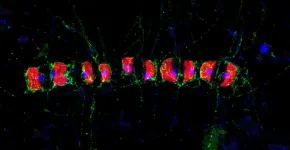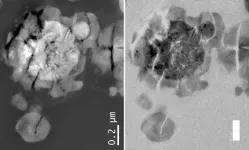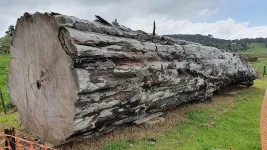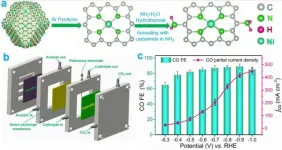INFORMATION:
Animal evolution -- glimpses of ancient environments
2021-02-19
(Press-News.org) Although amber looks like a somewhat unusual inorganic mineral, it is actually derived from an organic source - tree resins. Millions of years ago, when this aromatic and sticky substance was slowly oozing from coniferous trees, insects and other biological material could become trapped in it. That is why some samples of amber contain fossilized specimens, preserved in a virtually pristine state, which afford fascinating snapshots of the flora and fauna of long-gone forests. Now, a research team led by LMU zoologists Viktor Baranov and Joachim Haug has made exciting finds in samples of amber from the Baltic region and Myanmar, which provide new insights into the ecology of two groups of ancient insects.
In the Eocene period - between 56 and 33.9 million years ago - the Baltic amber forests covered (most likely around 38 million years ago) large areas of what is now Northern Europe, and were the source of most amber found in Europe. In one sample, the LMU team identified no less than 56 fly larvae, all of which were entombed while feasting on a single chunk of mammalian dung. "This fossil is particularly interesting, because the dung is full of plant residues, which implies the presence of at least moderately large herbivores in these forests," Baranov explains. On this basis, he and his colleagues assume that there must have been open areas of grassland nearby, corroborating earlier hypotheses. "The Baltic amber forest is often portrayed as a densely overgrown and humid jungle landscape. But it is much more likely that it was a more open, warm-to-temperate habitat," Baranov says.
In other samples, the researchers found insect larvae whose modern descendants are mainly found in association with plants that are under chronic stress. "It has long been suspected that forests which produced large amounts of amber were ecologically under stress," says Haug. "That would be perfectly compatible with the presence of these larvae." High temperature and dry conditions are the most probable source of such stress.
The unusual butterfly larva that Haug identified in amber from Myanmar is considerably older than the specimens from the Baltic. It dates to the Cretaceous, more than 100 million years ago, at a time when dinosaurs still dominated the Earth. Up until now, only four caterpillars from the Cretaceous had been discovered, and the new find is very different from all of them. "All of the previously discovered caterpillars were relatively naked", says Haug. "Our caterpillar is the first 'armored' specimen that has turned up - it bears spines dorsally on some of its segments." The new specimen thus supports the idea that butterflies underwent an early phase of diversification and also reveals some aspects of their ecology. In modern caterpillars, such spines serve as a deterrent to predators - more particularly, songbirds. "The rapid diversification of birds first sets in after the demise of the large dinosaurs, but small birds that may have fed on caterpillars were already extant during the Cretaceous," Haug points out.
ELSE PRESS RELEASES FROM THIS DATE:
An eco-route for heavy-duty vehicles could reduce fuel consumption
2021-02-19
Semi-trucks and other heavy-duty vehicles are responsible for nearly half of road transportation carbon dioxide emissions in Europe, according to the International Council on Clean Transportation. A team of researchers in Italy has proposed a plan to reduce the emissions without compromising priorities such as delivery times. They published their approach in IEEE/CAA Journal of Automatica Sinica, a joint publication of the IEEE and the Chinese Association of Automation.
"Driving style, traffic and weather conditions have a significant impact on vehicle fuel consumption. Road freight traffic, in particular, contributes ...
Sweet marine particles resist hungry bacteria
2021-02-19
A major pathway for carbon sequestration in the ocean is the growth, aggregation and sinking of phytoplankton - unicellular microalgae like diatoms. Just like plants on land, phytoplankton sequester carbon from atmospheric carbon dioxide. When algae cells aggregate, they sink and take the sequestered carbon with them to the ocean floor. This so called biological carbon pump accounts for about 70 per cent of the annual global carbon export to the deep ocean. Estimated 25 to 40 per cent of carbon dioxide from fossil fuel burning emitted by humans may have been transported by this process from the atmosphere to depths below 1000 meter, where carbon can be stored for millennia. ...
Life of a pure Martian design
2021-02-19
Early Mars is considered as an environment where life could possibly have existed. There was a time in the geological history of Mars when it could have been very similar to Earth and harbored life as we know it. In opposite to the current Mars conditions, bodies of liquid water, warmer temperature, and higher atmospheric pressure could have existed in Mars' early history. Potential early forms of life on Mars should have been able to use accessible inventories of the red planet: derive energy from inorganic mineral sources and transform CO2 into biomass. Such living entities are rock-eating microorganisms, called "chemolithotrophs", which ...
How the brain processes sign language
2021-02-19
The ability to speak is one of the essential characteristics that distinguishes humans from other animals. Many people would probably intuitively equate speech and language. However, cognitive science research on sign languages since the 1960s paints a different picture: Today it is clear, sign languages are fully autonomous languages and have a complex organization on several linguistic levels such as grammar and meaning. Previous studies on the processing of sign language in the human brain had already found some similarities and also differences between sign ...
42,000-year-old trees allow more accurate analysis of last Earth's magnetic field reversal
2021-02-19
The last complete reversal of the Earth's magnetic field, the so-called Laschamps event, took place 42,000 years ago. Radiocarbon analyses of the remains of kauri trees from New Zealand now make it possible for the first time to precisely time and analyse this event and its associated effects, as well as to calibrate geological archives such as sediment and ice cores from this period. Simulations based on this show that the strong reduction of the magnetic field had considerable effects in the Earth's atmosphere. This is shown by an international team led by Chris Turney from the Australian University of New South Wales, with the participation of Norbert Nowaczyk from the German Research Centre for ...
Artificial intelligence predicts nonlinear ultrafast dynamics in optics
2021-02-19
Researchers at Tampere University have successfully used artificial intelligence to predict nonlinear dynamics that take place when ultrashort light pulses interact with matter. This novel solution can be used for efficient and fast numerical modelling, for example, in imaging, manufacturing and surgery. The findings were published in the prestigious Nature Machine Intelligence journal.
Artificial intelligence can distinguish different types of laser pulse propagation, just as it recognizes subtle differences of expression in facial recognition. The newly found solution can make it simpler to design experiments in fundamental research and will allow algorithms ...
Amination strategy improves efficiency of CO2 electrocatalytic reduction
2021-02-19
Carbon dioxide (CO2) electrocatalytic reduction driven by renewable electricity can solve the problem of excessive CO2 emissions. Since CO2 is thermodynamically stable, efficient catalysts are needed to reduce the energy consumption in the process.
The single-atom catalysts immobilized on nitrogen-doped carbon supports (M-N/C) have been widely used for CO2 electrocatalytic reduction reaction due to their high atom utilization efficiency.
Recently, a research team led by Prof. LIU Licheng from the Qingdao Institute of Bioenergy and Bioprocess Technology (QIBEBT) of the Chinese Academy of Sciences (CAS) proposed a two-step amination strategy to regulate the electronic structure of M-N/C catalysts (M=Ni, Fe, Zn) and enhance the intrinsic activity of CO2 electrocatalytic reduction.
In ...
Oregon experiments find that electrical sparks are possible on Mars
2021-02-19
EUGENE, Ore. -- Feb. 19, 2021 -- Friction caused by dry Martian dust particles making contact with each other may produce electrical discharge at the surface and in the planet's atmosphere, according University of Oregon researchers.
However, such sparks are likely to be small and pose little danger to future robotic or human missions to the red planet, they report in a paper published online and scheduled to appear in the March 15 print issue of the journal Icarus.
Viking landers in the 1970s and orbiters since then detected silts, clays, wind-blown bedforms and dust devils on Mars, raising questions about potential electrical activity.
Scientists ...
Northern Hemisphere cold surges result of Arctic and tropical Pacific synergistic effects
2021-02-19
China is just one of many countries in the Northern Hemisphere having what researchers are calling an "extremely cold winter," due in part to both the tropical Pacific and the Arctic, according to an analysis of temperatures from Dec. 1, 2020, to mid-January of 2021. A country-specific case study, the investigation potentially has far-reaching implications for predictions and early warnings to protect against harmful impacts, researchers said.
The results were published online, ahead of print, on Feb. 12 in Advances in Atmospheric Sciences.
"We are trying to explain why the countries in the Northern Hemisphere ...
Dynamics of nanoparticles using a new isolated lymphatic vessel lumen perfusion system
2021-02-19
Nanoparticles used in drug delivery systems, bioimaging, and regenerative medicine migrate from tissues to lymphatic vessels after entering the body, so it is necessary to clarify the interaction between nanoparticles and lymphatic vessels. Although technology to observe the flow of nanoparticles through lymphatic vessels in vivo has been developed, there has been no method to evaluate the flow of nanoparticles in a more detailed and quantitative manner ex vivo. Thus, research was conducted to develop an ex vivo lymphatic vessel lumen perfusion system to determine how nanoparticles move in lymphatic vessels and how they affect the physiological movement of lymphatic vessels.
Nanoparticles introduced into the ...




